感谢肖为本文提供英文朗读录音,点击上方音频可听。
Since I heard about the flax museum from Karin last time, I have been looking for a proper date and route to visit there. However, I failed to find any public transportation to and from there to its nearest city on weekends. It is in the countryside of Fyn, around 160 km away from Copenhagen. Luckily, my colleague Kathrine showed me great kindness to drive me there and visit the museum with me together.
自从上次Karin向我推荐了亚麻博物馆,我一直在寻找合适的日期与路线前往参观。但这个博物馆在菲英岛的乡下,距离哥本哈根约160公里远,我没能找到周末往返此地与其最近城市的公共交通。最后,我的同事Kathrine非常热心地提出可以开车载我去,并和我一起参观。
On Jun 3rd 2023, I took a train to Korsør between Kathrine’s home and Fyn. She picked me up at the train station and drove me to the Flax Weaving Museum (Danish: Hørvævsmuseet). We went over the Great Belt Bridge (Danish: Storebæltsbroen) and were amazed by the picturesque sceneries of the big blue sea. Kathrine introduced this bridge and the two islands of Denmark it linked to me. One hour later, we passed by several old houses in the countryside of Fyn and reached the museum which is hidden in woods and trees.
2023年6月3日,我坐火车去了位于Kathrine家和菲英岛之间的科瑟。Kathrine从科瑟火车站接上我,开车带我去了亚麻织造博物馆(丹麦语:Hørvævsmuseet)。路上我们经过了大贝尔特桥(丹麦语:Storebæltsbroen),欣赏了风景如画的碧蓝大海,Kathrine向我介绍了这座桥及其连接的两座丹麦大岛。一小时后,我们路过菲英岛乡下的数栋老房子,抵达隐身丛林的博物馆。
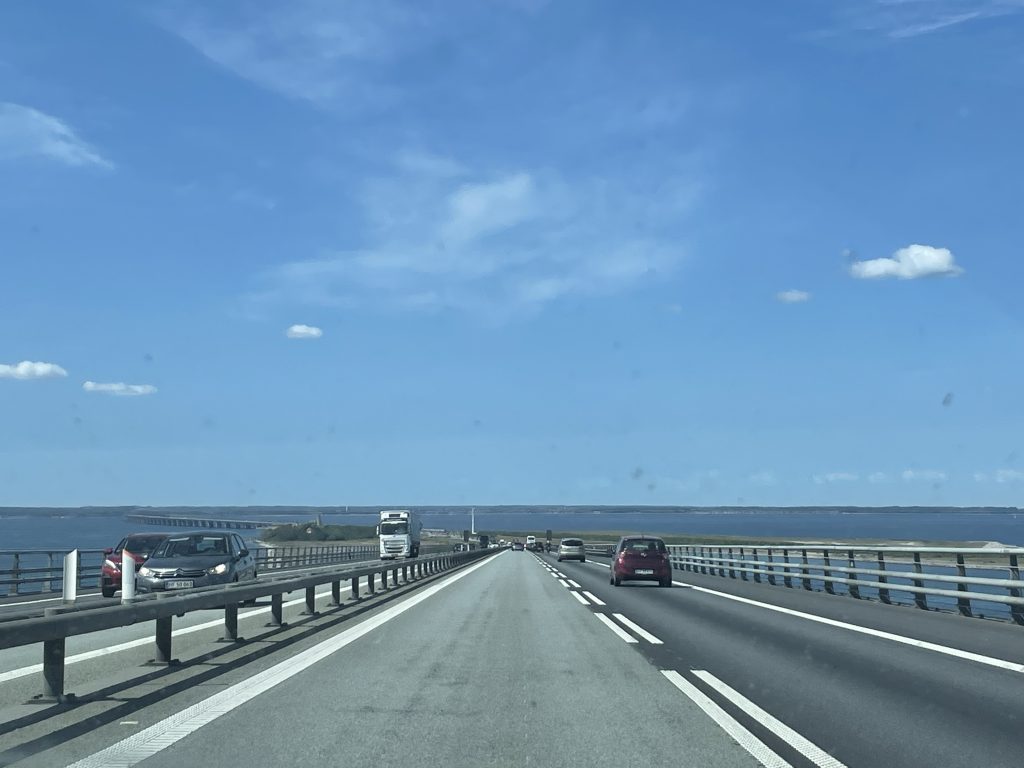
行驶在大贝尔特桥上

博物馆的大院子和厂房
This museum is reconstructed from an old farm owned by a wealthy family in the past. It has a big yard with several warehouses which were used to raise livestock. Once we entered the museum, Kathrine recognized a woman she knew called Lis, who is now volunteering to be an interpreter and she told us there would be a guided tour later. We felt so lucky that we visited this place at this time and got a guided tour from Lis, without any other tourists.
这座博物馆从以前一户富人家的农场改造而来,有一个大院子和几座以前用来圈养牲畜的厂房。一进博物馆,Kathrine就认出了一个熟人,名叫Lis,现在在这里做志愿讲解。Lis跟我们说,一会儿这里会有导览,然后我们就享受了没有其他游客参与的导览服务,运气真好。
Lis led us to start with a glass box of flax samples from seeds to stalks, then processed fibres and yarns. There are also boards on the wall introducing procedures for planting and processing flax, nearly all in Danish.
Lis先带我们看了一个玻璃匣子,里面按顺序展出了亚麻的种子、茎秆、加工后的亚麻纤维和纱线。墙上也有介绍亚麻种植与加工工序的展板,几乎都是丹麦语。
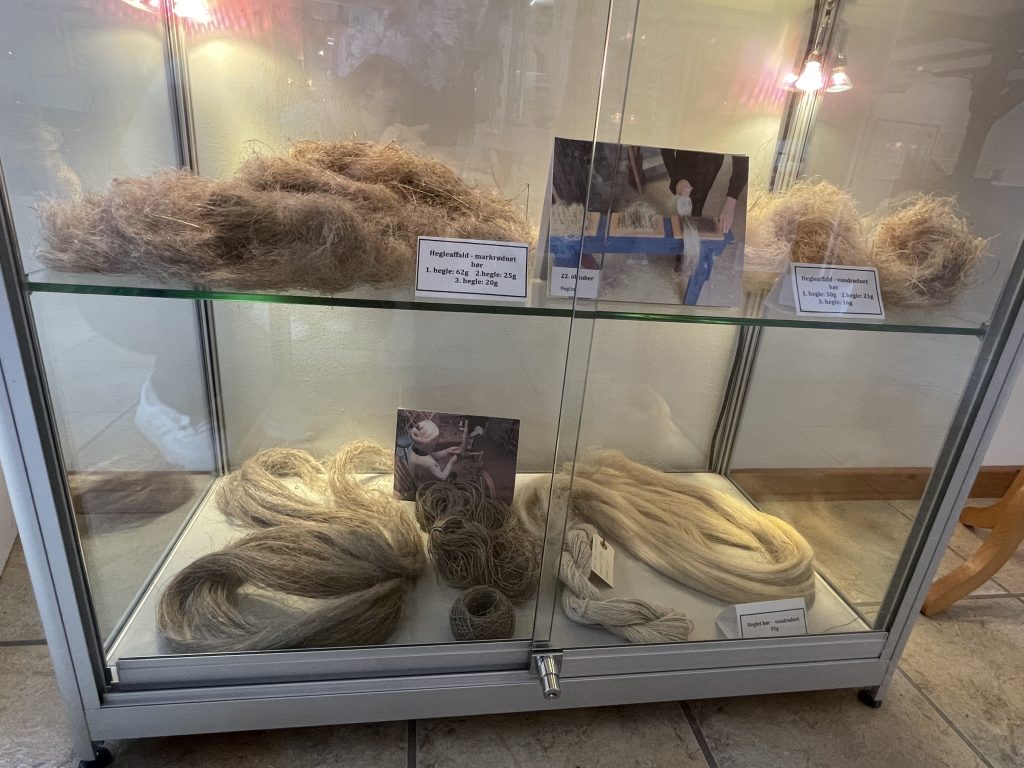
展示亚麻样品的玻璃匣
Then we saw several volunteers working with a traditional band-weaving machine and a spinning wheel to weave flax bands and spin flax yarns. After I finished my visit in the museum and came back here, I asked to take a practice on the spinning wheel and the volunteer agreed. It is under the same principle to spin yarns as that using a spindle——a more primitive spinning tool——but faster and more efficient than using spindles.
然后我们见到几个志愿者,正在用传统带织机编织亚麻条带、用纺车纺亚麻纱线。在我结束了博物馆的参观回到这里时,我请求让我试一下纺车纺纱,志愿者同意了。这和使用纺专(一种更原始的纺纱工具)的纺纱原理是一样的,但比它更快、更高效。

用带织机编织亚麻条带
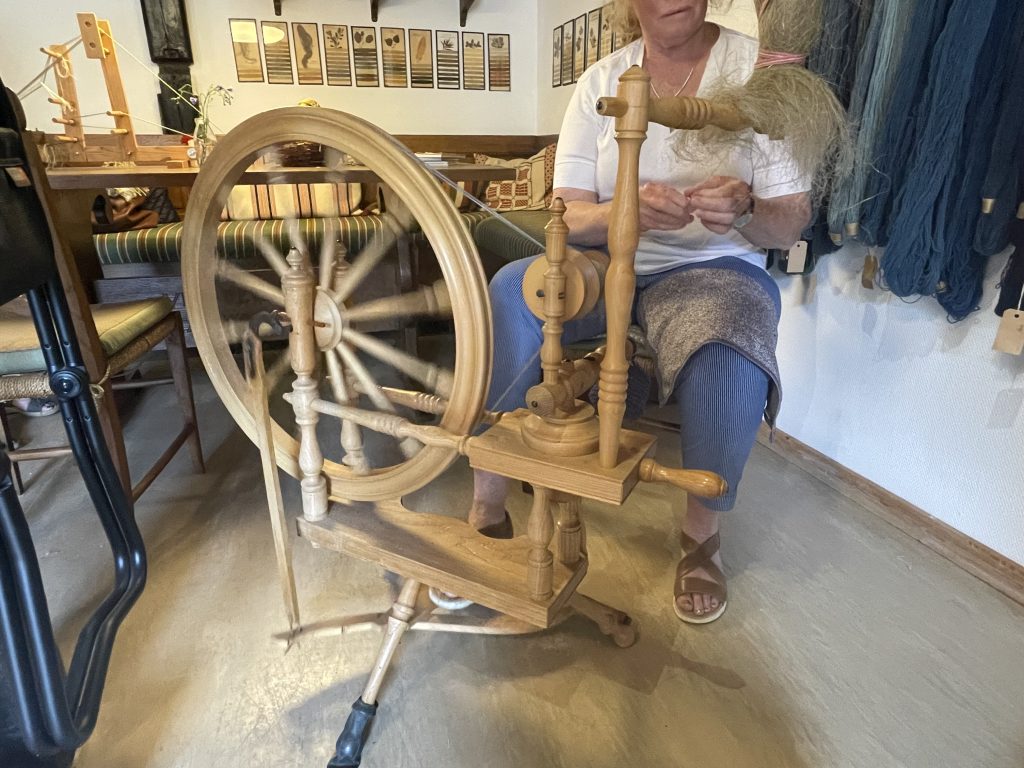
用纺车纺亚麻纱线
The volunteer told me she was 67 years old, which I couldn’t believe. She lives in a house near the museum, owning a farm and rearing some animals including rabbits. She said this spinning wheel was her own. She brought her own spinning wheel to this museum working as a volunteer to show flax spinning. She spins yarns at her home as a hobby, from different fibres including the hairs from her rabbits.
志愿者告诉我她已经67岁了,真让人难以置信。她家就在这个博物馆附近,有自己的农场,养一些动物,其中有兔子。她说这个纺车是她自己的东西,她把她自己的纺车带来博物馆向游客展示亚麻纺纱。作为兴趣爱好,她会在家用不同的纤维原料纺纱,包括用她自己养的兔子身上的兔毛。
Back to the start of our visiting the museum, there is a small space showing the experimental equipment and yarns of a pioneer researcher Mule Henningsen on natural dyeing in Denmark. As was introduced, at the time Mule was living, chemical dyeing arose and fewer people had the knowledge of traditional natural ways of dyeing. Then, Mule started her experimental archaeology research on natural dyeing and did a lot of experiments. When she was 97 years old, she donated all her experimental stuff to the Flax Weaving Museum, where we can see them today.
回到此次参观的起点,那儿有一小块地方展示Mule Henningsen的染色器具与纱线。Mule是丹麦天然染色实验研究的先锋。据介绍,在她生活的年代,化学染料染色兴起,天然染料染色的知识逐渐变得不为人知,于是Mule开始了她对天然染料染色的实验考古研究,做了大量实验。97岁的时候,她将所有的实验器材捐给了亚麻织造博物馆,我们得以在今天看到它们。
We followed Lis to enjoy the journey of the development of Danish looms in modern history, which is the main part of this museum. In general, it was an evolution from simple to intricate, from machinery to computerized. Actually, the invention of the binary system of the first computer in the world was technically inspired by the principle of using punched cards to lift specific heddles on the Jacquard loom, which was invented by a French man called Jacquard in the 18th century.
我们跟随Lis的讲解,了解了丹麦近代织机的发展历程,这也是博物馆的主要部分。总的来说,这是一段从简单到复杂,从机械化到电子化的演变过程。其实,世界上第一台计算机的二进制系统,就是受到贾卡织机中纹板提花原理的启发而发明出来的。贾卡织机由一个叫贾卡的法国人于18世纪发明。
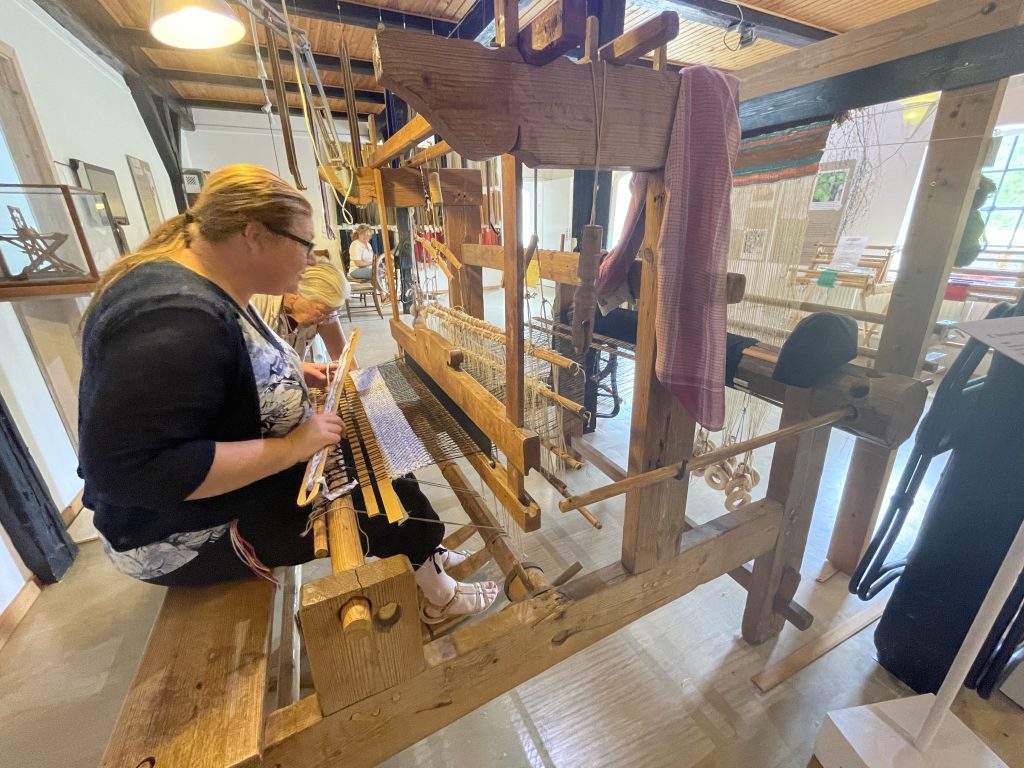
丹麦的旧踏板织机
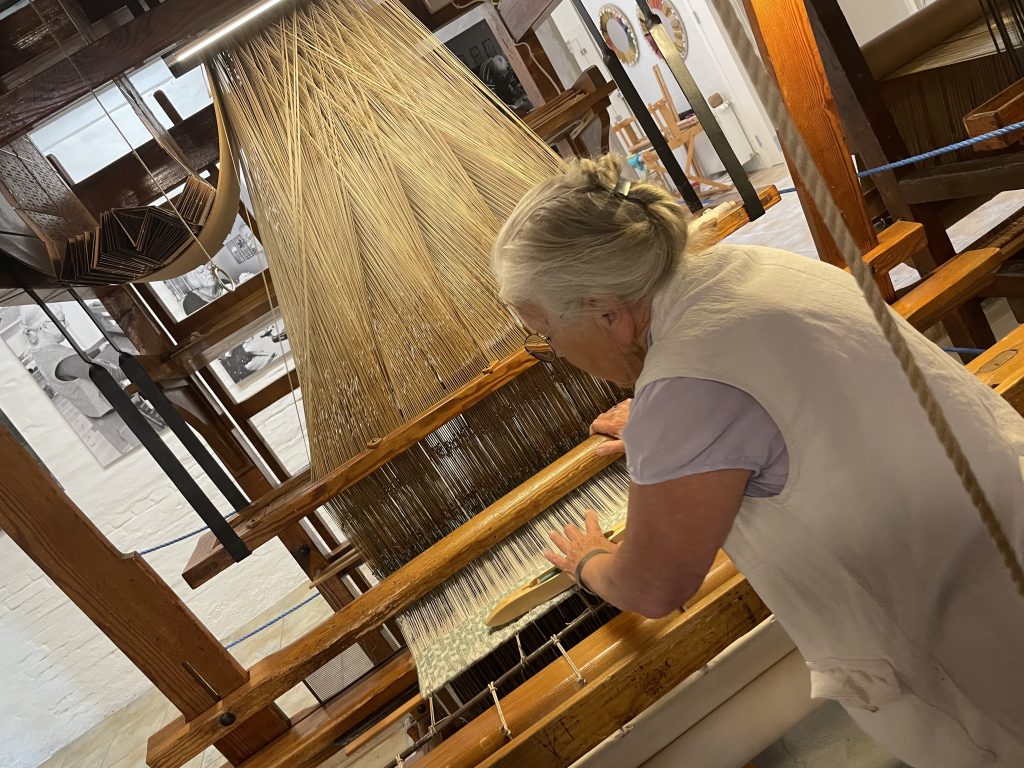
贾卡织机
As I learned modern ways of producing cotton fabrics from simple structures to complicated patterns for my Bachelor’s degree, I know well about the development of modern looms. Materials are different but both cotton and flax weaving follow the almost same progress under the development of looms before and after the Industrial Revolution. As a result, I didn’t spend much time reading the details on cards and understanding how they work. It was a time for me to see the real old looms and punched cards, as well as the original machines and tools to make those cards, which I could only know from books in the past.
我本科学过棉织物从基础结构到复杂组织的现代生产方法,因此对近代织机的发展比较了解。尽管原料不同,棉织物和亚麻织物都随着工业革命前后织机的发展,有着大致相同的织造进程。所以,我没有花太多时间阅读展板细节,理解这些机器的工作原理。以前我只在书上了解到这些古旧织机、纹板以及最初制作纹板的机器,这次我看到了实体。
By the way, there is a portrait of Jacquard with an introduction to how his loom works. I thought it was a printed painting but it was a printed picture of a patterned fabric produced from the loom invented by the man on the fabric.
这里还有一张贾卡的肖像画以及贾卡织机的工作原理示意图。我以为这张肖像图是打印的画作,结果它是打印的织物照片,这块织物是用贾卡(提花)织机织出来的贾卡肖像。
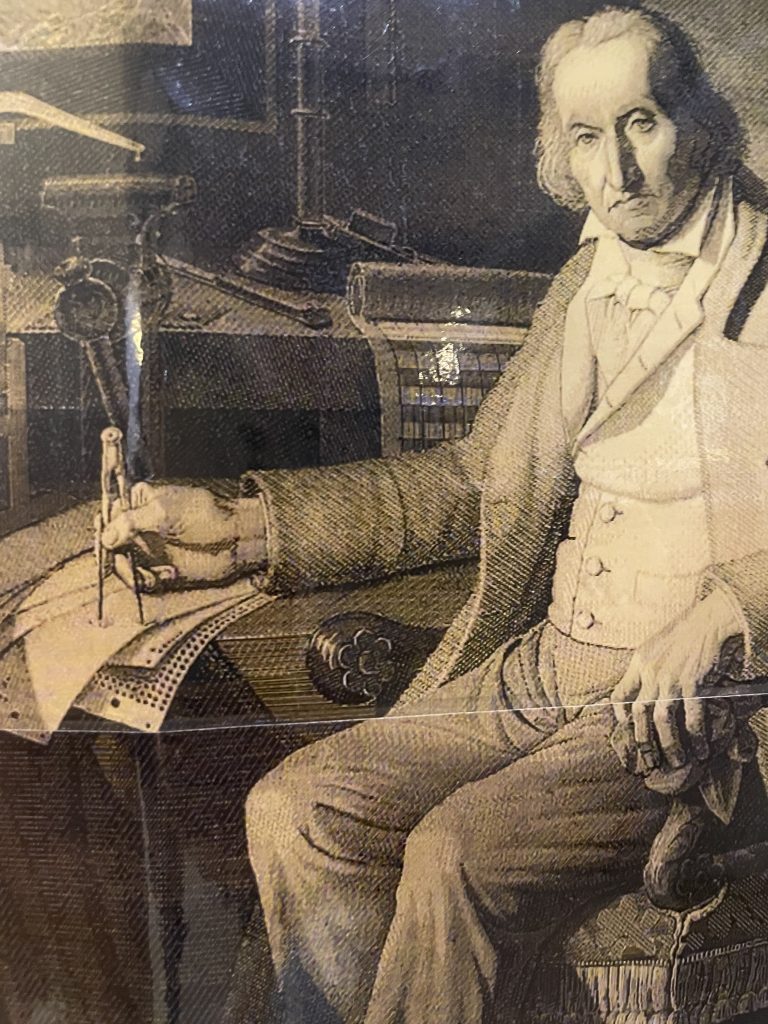
贾卡织机织出来的贾卡肖像
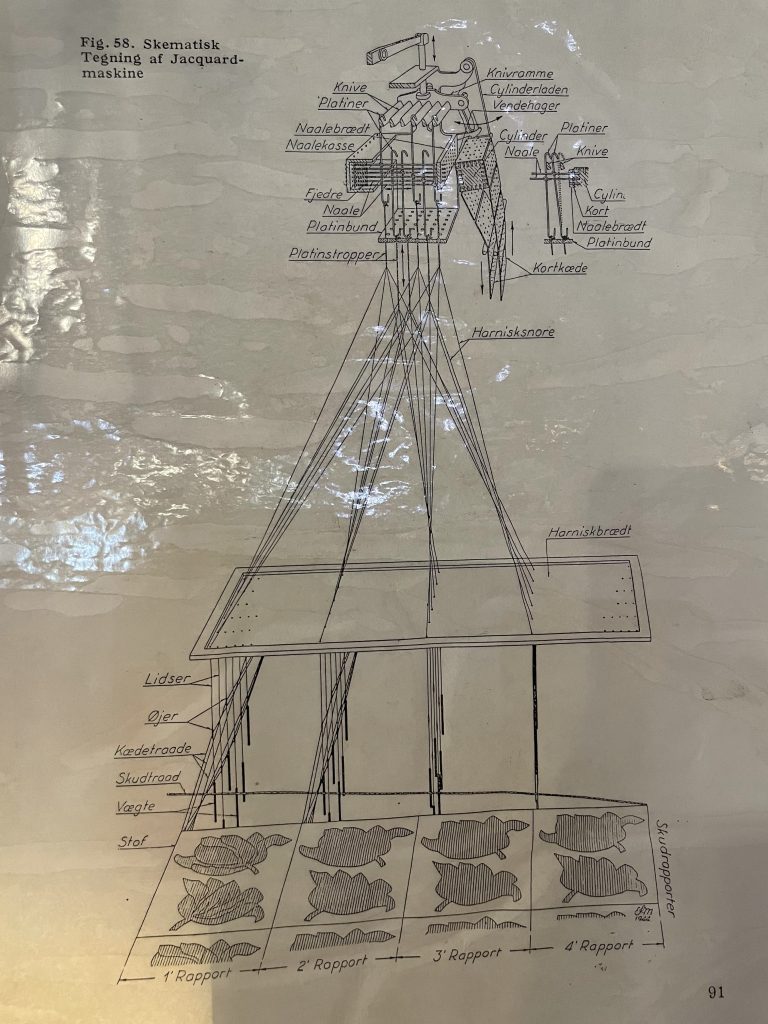
贾卡织机的结构
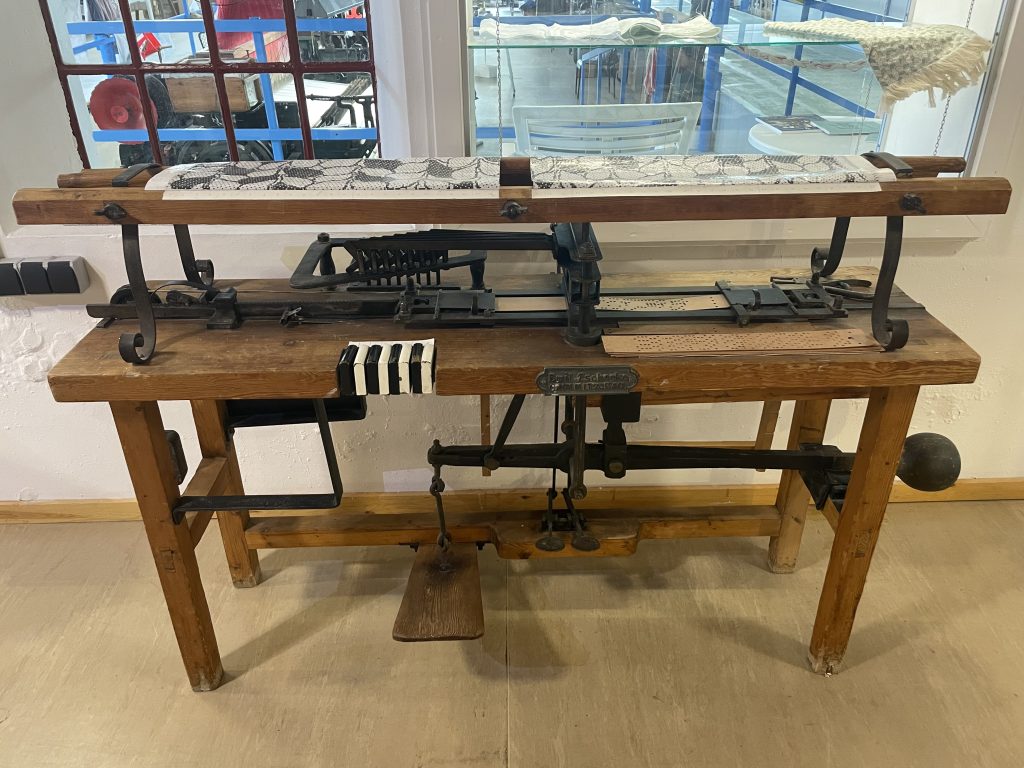
打制纹板的机器
Inside the museum, there is a space with a group of looms from closed factories. This space used to be a place feeding cows but now to display these looms. Lis started one of them to show us how a loom works, which brought me back to my production practice in a weaving factory in China. I told Kathrine it was not too noisy for me because I had been in a factory with about 50 looms working simultaneously, where we must use earplugs every day.
博物馆里还有一组来自倒闭工厂的织机,展示这些织机的空间是以前喂牛的地方。Lis启动了一台织机来向我们展示它们如何运转,让我仿佛回到了大学时期在一个织布厂的生产实习经历。我告诉Kathrine,这对我来说倒不是很吵,因为我曾在一个织布车间实习,那里每天有差不多50台织机同时运转,我们必须配戴耳塞。
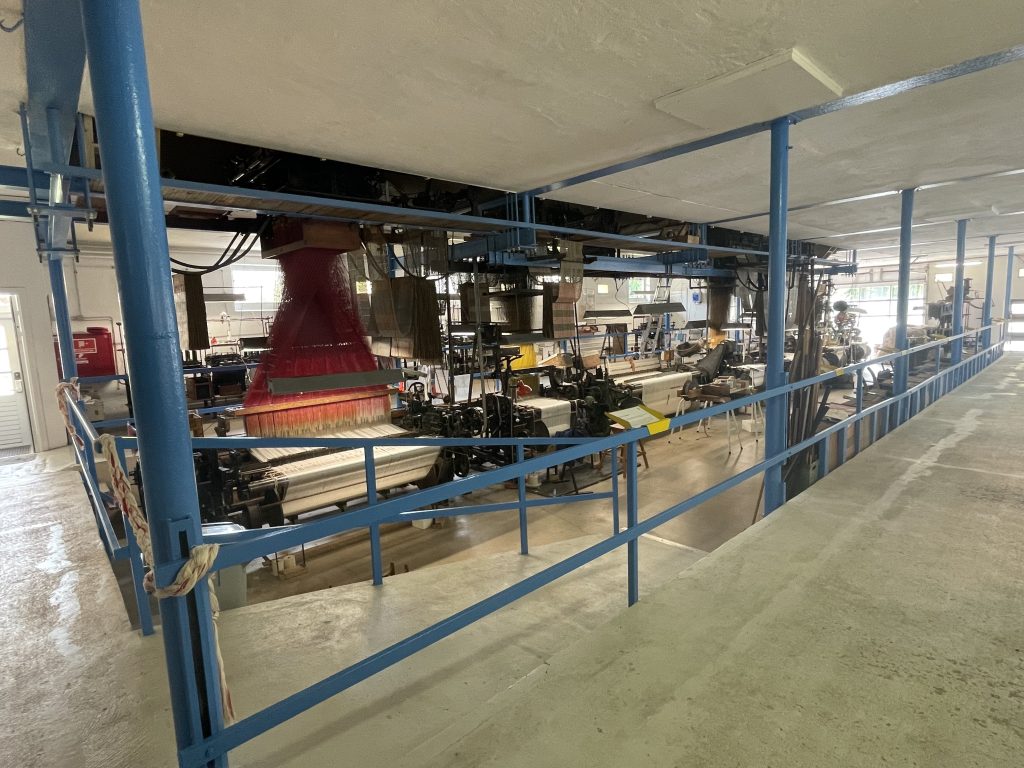
来自倒闭工厂的织机
After seeing the looms, Lis took us to a room with flax tablecloth samples produced from them. I was impressed by two of those samples, one is woven with a pattern showing the thumb girl from the fairy tales of Hans Andersen (I didn’t recognize the pattern at first), and another is woven with a so-called tourist pattern, on which there are Runes around the edge and pattern designed from four main crops in Denmark——wheat, barley, oats and rye.
看完织机,Lis领我们看了一些用那些织机生产的亚麻桌布样品,其中有两种让我印象较深:一种织的是《安徒生童话》里拇指姑娘的图案,一开始我没认出来;另一种织着被称为“游客图案”的纹样,其边缘由卢恩字母包围,中间是以丹麦四大作物——小麦、大麦、燕麦和黑麦为灵感设计创作的图案。
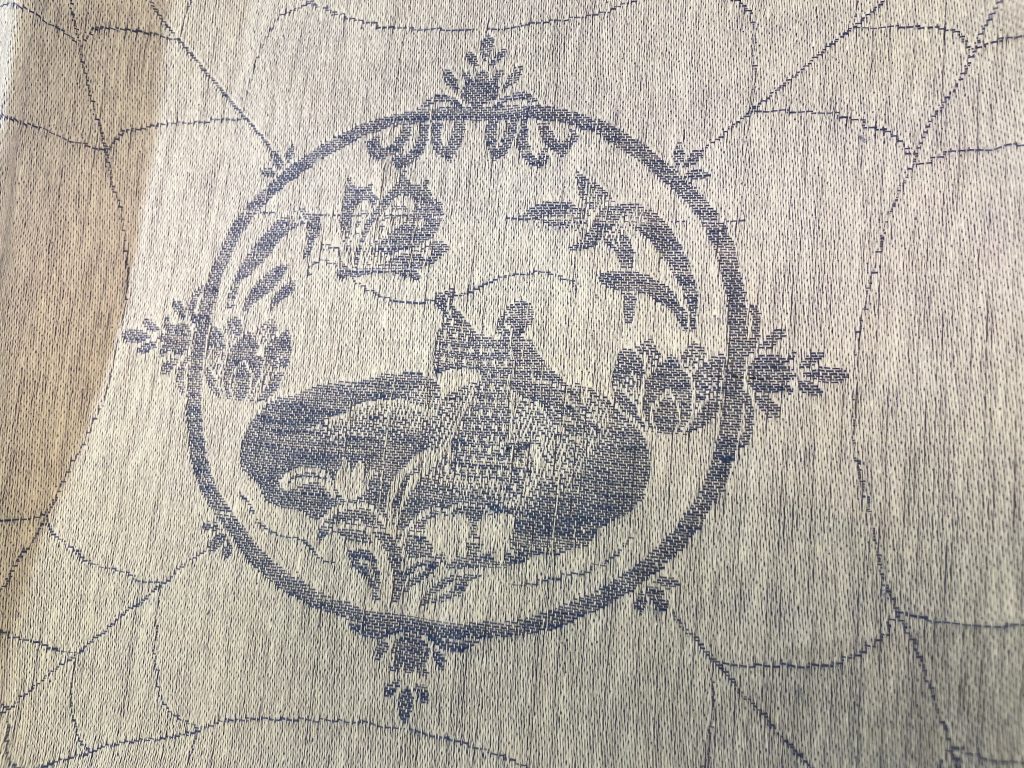
“拇指姑娘”纹样
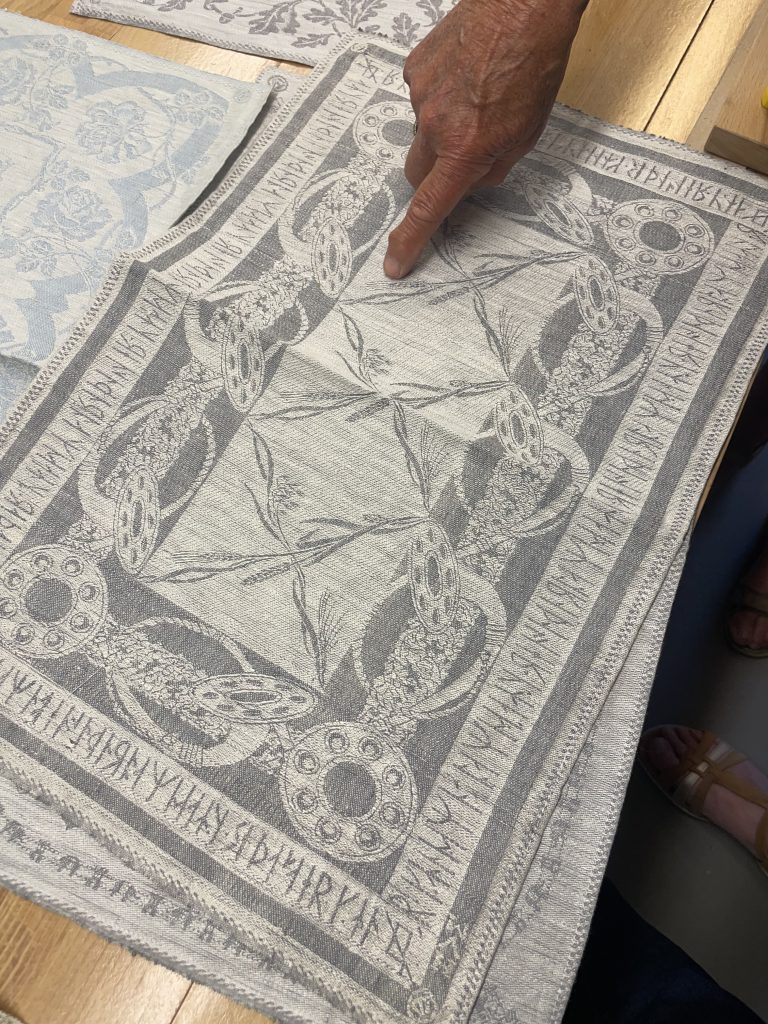
”丹麦“游客图案”
The guided tour was almost ended. I went upstairs with Kathrine and saw workshops with old looms looking like new ones, for both adults and children. Kathrine is working on a project, Save the Loom, about those old looms in Denmark. So she knew well about them and could recognize their production times according to the brands or stamps on their bodies.
导览差不多结束了,我和Kathrine上楼看了一些用旧织机布置的工作坊,既有面向成人也有面向儿童的课程。这些织机因为保存完好,看起来像新的一样。Kathrine正在为一个与丹麦旧织机有关的项目“拯救织机”工作,因此对这些旧织机了如指掌。她可以根据织机上的品牌标志或印章,判断该织机的大致生产年代。

摆着小型旧织机的儿童工作坊
Kathrine told me, there is another museum about flax in Denmark (Køng Museum) but that one shows the history mainly in pictures with introductions, which sounds less interesting. So I could say, I visited the best museum of flax in Denmark this day.
Kathrine跟我说,丹麦还有另一家亚麻相关的博物馆(Køng Museum),但那家主要是用图片和文字介绍来展示亚麻产业的历史,相比之下比较无趣。所以我可以说,我今天参观了全丹麦最好的亚麻博物馆。
This museum seems mainly open to local Danes with cars. I cannot make this day without help from Kathrine. At the end of this article, I would like to show my great appreciation for all the help, stories, nice conversations and beautiful views she brought me on this lovely and important trip.
这个博物馆似乎主要针对有车的丹麦本地人开放,要不是Kathrine帮我,我都无法完成本次参观。这对我来说是一段非常小型却很重要的旅程,Kathrine开车带我来此参观,一路上与我分享了许多故事与漂亮的风景。在这篇文章的结尾,我要向她表达我最诚挚的谢意。
You helped me a lot by posting this article and I love what I’m learning.
There’s a quiet wisdom in every sentence, as though each word is carefully selected to provide just the right amount of insight.
Thanks for sharing excellent informations. Your web-site is so cool. I’m impressed by the details that you have on this website. It reveals how nicely you understand this subject. Bookmarked this web page, will come back for more articles. You, my friend, ROCK! I found just the information I already searched everywhere and simply couldn’t come across. What a great web site.
I don’t even know how I ended up here, but I thought this post was good. I do not know who you are but definitely you are going to a famous blogger if you are not already 😉 Cheers!
whoah this blog is magnificent i love reading your articles. Keep up the great work! You understand, many persons are looking around for this info, you could help them greatly.
Great post. I was checking constantly this blog and I am impressed! Extremely useful information specifically the last part 🙂 I care for such information a lot. I was seeking this certain info for a long time. Thank you and good luck.
Thanks for your comment!